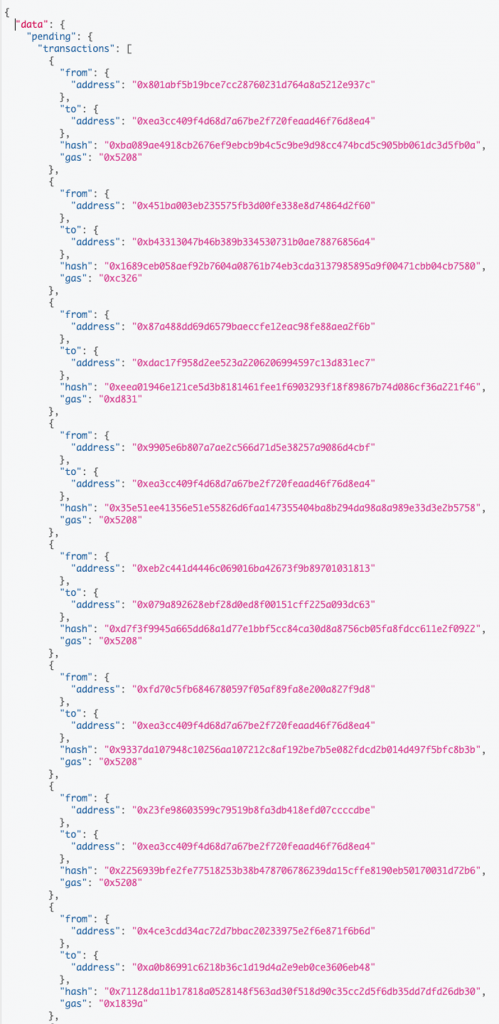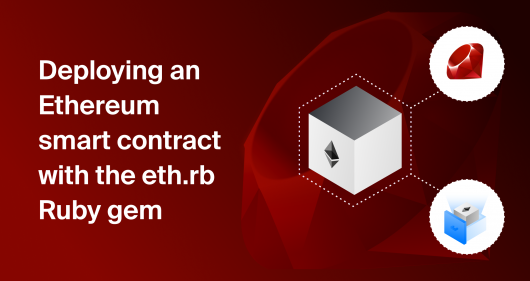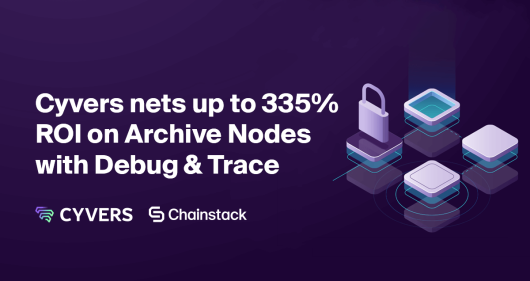Querying pending transactions with GraphQL from Geth

A GraphQL endpoint is a useful alternative to JSON-RPC, especially when querying a large amount of data. Using GraphQL can reduce resource consumption significantly since it is lightweight and more resource-efficient. Currently, GraphQL is natively supported on Ethereum, BNB smart chain, and Fantom.
This tutorial shows you how to use GraphQL to fetch pending transaction data from Geth. And compares GraphQL and JSON-RPC in terms of speed and data size.
Prerequisites
- A dedicated Ethereum node from Chainstack.
- A web browser
GraphQL is available on dedicated Ethereum nodes on Chainstack, starting from the Growth plan. Follow this guide to set up your own dedicated node.
Once the node is ready, the GraphQL endpoint can be found in your console:

How it works
In GraphQL IDE
Geth comes with a native GraphQL IDE, users can access it at the following URL:
https://**********/graphql/ui
All you need to do is fill in the query and click the run button.

You will get a list of pending transactions in the result panel:

With JavaScript
Create an empty HTML file and paste the following code into it.
<html>
<header>
<script src="https://ajax.googleapis.com/ajax/libs/jquery/3.6.0/jquery.min.js"></script>
</header>
<body>
<div class="result"></div>
</body>
<script>
//Fill in your httpURL and graphQLURL here
var httpURL = ""
var graphQLURL = ""
var startTime = new Date().getTime()
console.log("Program start timestamp:" + startTime)
var dataGraphQL = '{"query": "query{pending{transactions{hash,gas,s,r}}}"}'
$.ajax({
type: "POST",
contentType: "application/json",
url: graphQLURL,
data: dataGraphQL,
success: function(res) {
resultTime = new Date().getTime() - startTime
console.log("graphQL gets result in " + resultTime + "ms")
$(".result").text(JSON.stringify(res));
console.log(res);
}
});
var dataRPC = '{"jsonrpc":"2.0","method":"txpool_content","id":1}'
$.ajax({
type: "POST",
contentType: "application/json",
url: httpURL,
data: dataRPC,
success: function(res) {
resultTime = new Date().getTime() - startTime
console.log("RPC gets result in " + resultTime + "ms")
console.log(res);
}
});
</script>
</html>Remember to fill in the URL for both http and graphQL endpoints at line 11.

Open the HTML file with any browser to see its output:

Measuring the performance
The above JavaScript code also measures the latency of data retrieval. You need to open the developer console to see it.

Comparing latency for 7 rounds.
| GraphQL query time(ms) | RPC query time(ms) | RPC/GraphQL*100% |
| 813 | 1317 | 161.99% |
| 891 | 1499 | 168.24% |
| 3731 | 4281 | 114.74% |
| 581 | 1176 | 202.41% |
| 3053 | 3624 | 118.70% |
| 419 | 1025 | 244.63% |
| 1735 | 2540 | 146.40% |

Overall, GraphQL takes 60% of the time for data loading. The response object is only 40% in size compared to an RPC endpoint.
Please also take note that:
- In the test case, the RPC endpoint not only returns the pending transactions but also queue transactions.
- GraphQL does not retrieve the full object. It only contains four fields: hash, gas, s, and r.
GraphQL is more resource effective because users can specify which fields to retrieve.
Conclusion
This is the end of this article. If you have any questions, feel free to ping us on our Telegram and Discord.
Cheers!
Happy coding.
- Discover how you can save thousands in infra costs every month with our unbeatable pricing on the most complete Web3 development platform.
- Input your workload and see how affordable Chainstack is compared to other RPC providers.
- Connect to Ethereum, Solana, BNB Smart Chain, Polygon, Arbitrum, Base, Optimism, Avalanche, TON, Ronin, zkSync Era, Starknet, Scroll, Aptos, Fantom, Cronos, Gnosis Chain, Klaytn, Moonbeam, Celo, Aurora, Oasis Sapphire, Polygon zkEVM, Bitcoin and Harmony mainnet or testnets through an interface designed to help you get the job done.
- To learn more about Chainstack, visit our Developer Portal or join our Discord server and Telegram group.
- Are you in need of testnet tokens? Request some from our faucets. Multi-chain faucet, Sepolia faucet, Holesky faucet, BNB faucet, zkSync faucet, Scroll faucet.
Have you already explored what you can achieve with Chainstack? Get started for free today.
 Ethereum
Ethereum Solana
Solana TON
TON Base
Base BNB Smart Chain
BNB Smart Chain Sui
Sui Unichain
Unichain Aptos
Aptos TRON
TRON Ronin
Ronin zkSync Era
zkSync Era Sonic
Sonic Polygon
Polygon Gnosis Chain
Gnosis Chain Scroll
Scroll Avalanche Subnets
Avalanche Subnets Polygon CDK
Polygon CDK Starknet Appchains
Starknet Appchains zkSync Hyperchains
zkSync Hyperchains



























